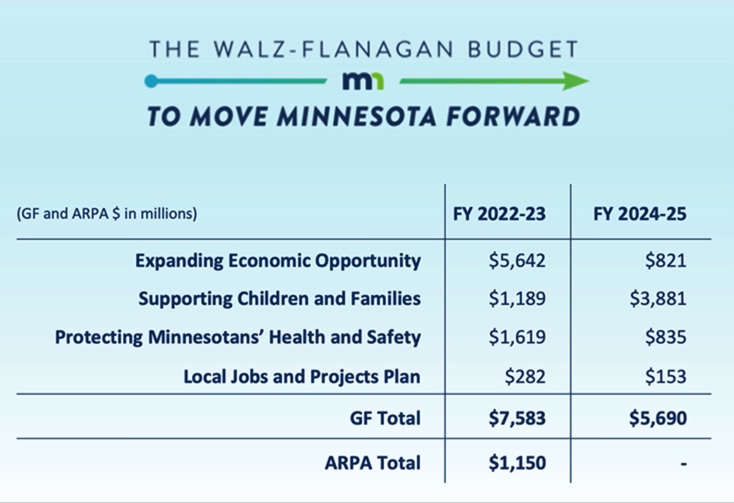Walz wants to use nearly the entire surplus on more govt. spending
The Minnesota legislative session starts next Monday. In anticipation, Governor Tim Walz has unveiled his full supplemental spending plan for the surplus. Here is the full breakdown of Walz’s spending plan.

2022-2023 binneum
The Minnesota Management and Budget (MMB) forecast a $7.746 billion surplus for the 2022-2023 biennium. In addition to that, Minnesota also has $1.15 billion in unspent American Rescue Plan (funds). Together, the Minnesota government has $8.89 billion going into the session.
Gov. Walz plans to spend $8.7 billion –– $7.5 billion from the surplus, and $1.15 billion from the federal unspent funds. Out of that, only $1.7 billion will go back to Minnesotans through direct checks to households and frontline worker pay.
The rest of the surplus will be spent on various programs. A big chunk of the 2022-2023 surplus –– $5.64 billion –– will be spent on the “Expanding Economic Opportunity” plan. Some of the spending programs under this plan include replenishing the Unemployment Insurance Trust Fund, funding higher education and training, and funding workforce development grants.
About $2.3 billion will go towards programs aimed at health and safety, as well as children and families. Walz wants to expand funding for E-12 and childcare assistance and create a state family and medical leave program, among numerous other programs.
2024-2025 binneum
Spending programs in the 2022-2023 biennium have a carry-forward total cost of $5.7 billion. This takes up nearly the total projected surplus for that biennium –– $5.953 billion. The majority of that spending will go to long-term spending plans in childcare, E-12, and paid family and medical leave programs, among others.
And since some of the spending on these programs is ongoing, it means that Minnesotans will be on the hook for even more spending beyond 2025.
Very little will go back to Minnesotans
For the 2022-2023 and 2024-2025 biennium, Minnesota is projected to have a 13.7 billion surplus. Out of that, however, only $703 million –– about 5 percent –– of the surplus will go back directly to taxpayers.
Gov. Walz has also proposed increasing frontline worker pay by $1 billion. But this will be covered by the unspent federal funds.
Certainly, the plan includes some programs that increase tax credits, thereby reducing taxes for some businesses, families, and working individuals. But those tax credits add up to a little less than $500 million. This means that less than 10 percent of the surplus will go back to individuals or businesses through payments or tax credits.
Moreover, the tax credit programs directly affecting workers and families, like the expansion of the K-12 education tax credit as well as the child and dependent tax credit, add up to less than $120 million.
So, not counting the checks to frontline workers, which will come out of ARP funds, in total, only $820 million of the $13.7 billion –– 6 percent –– is geared towards individual tax relief programs (highlighted below in yellow).

The problem with the plan
Most of these spending programs have their own problems, as I have written before. And while replenishing the Unemployment Insurance Trust Fund is commendable, that is something that could have been addressed in the last legislative session using mainly COVID-19 relief funds, as most states have done.
But even currently, there is a chance to replenish the fund and still offer significant tax relief to Minnesotans. Taking $2.7 billion to replenish the trust fund, for example, still leaves about $5 billion that legislators could give back to Minnesotans in the next biennium instead of increasing spending. Including the 2024-2025 biennium, that number goes up to about $11 billion.
Walz’s plan has little tax relief for Minnesotans and instead focuses on increasing spending. But what is more concerning is the fact that the plan will add billions in long-term spending to the budget. This will put Minnesotans on the hook for potentially higher taxes in the near future.
Take Action – Give the Surplus Back to Minnesotans
The biggest question of the 2022 legislative session is what to do with the state’s record-breaking $7.7 billion budget surplus.
Governor Walz already has a long wish list to spend it on more government programs.
We say GIVE IT BACK!
The last thing our government needs is more money to spend on failed ideas.